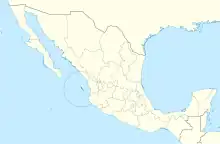Tres Marias hummingbird
The Tres Marías hummingbird (Cynanthus lawrencei) is a Near Threatened species of hummingbird in the "emeralds", tribe Trochilini of subfamily Trochilinae. It was formerly considered to be a subspecies of the broad-billed hummingbird. It is endemic to the Islas Marías island group off the west coast of Mexico.[2][3]
| Tres Marias hummingbird | |
|---|---|
| Scientific classification | |
| Domain: | Eukaryota |
| Kingdom: | Animalia |
| Phylum: | Chordata |
| Clade: | Dinosauria |
| Class: | Aves |
| Clade: | Strisores |
| Order: | Apodiformes |
| Family: | Trochilidae |
| Genus: | Cynanthus |
| Species: | C. lawrencei |
| Binomial name | |
| Cynanthus lawrencei (Berlepsch, 1887) | |
 | |
Taxonomy and systematics
The Tres Marias hummingbird was long treated as a subspecies of the broad-billed hummingbird. Based on 2014 and 2017 publications, by the end of 2022 the North American Classification Committee of the American Ornithological Society (AOS), the International Ornithological Committee (IOC), BirdLife International's Handbook of the Birds of the World (HBW), and the Clements taxonomy had recognized it as a species.[4][5][6][2][3][7]
Description
The Tres Marias hummingbird has a broad reddish bill with a black tip. Both sexes have metallic bronze-green upperparts that is somewhat duller on the forehead and crown. Males have a turquoise-green to emerald green throat, a greeny-bronze breast, a dark green belly, and dark undertail coverts. The tail is glossy blue-black. Females' upperparts are duller than the male's and they have gray underparts. The base of their tail is bronze-green and the rest blue-black to greenish black with white tips on the outermost two pairs of feathers.[8]
Distribution
The Tres Marias hummingbird is found only on María Madre and María Cleofás of the Islas Marías, an island group off the coast of Nayarit, Mexico. Their specific habitat there has not been described.[8]
Behavior
Movement
The Tres Marias hummingbird is mostly sedentary but individuals have been collected in mainland Nayarit.[8]
Feeding
The diet of the Tres Marias hummingbird has not separately described from that of the broad-billed hummingbird. In general, and like most hummingbirds, that species feeds on a wide variety of flowering plants and also small arthropods.[8]
Vocalization
The Tres Marias hummingbird's vocalizations have not been separately described from those of the broad-billed hummingbird. That species' song, sung only by males, "[b]egins with short chip note, then a series of similar notes ranging in frequency from 2 to 13 kHz."[8]
Status
The IUCN has assessed the Tres Marias hummingbird as Near Threatened. It has a very small range and an estimated population of under 2500 mature individuals, though the population is believed to be stable. The potential threats include habitat destruction through urbanization, farming, and wood-cutting, and predation by invasive species.[1]
References
- BirdLife International (2020). "Tres Marias Hummingbird Cynanthus lawrencei". IUCN Red List of Threatened Species. 2020. Retrieved 24 August 2022.
- Gill, F.; Donsker, D.; Rasmussen, P., eds. (August 2022). "Hummingbirds". IOC World Bird List. v 12.2. Retrieved August 9, 2022.
- HBW and BirdLife International (2021) Handbook of the Birds of the World and BirdLife International digital checklist of the birds of the world. Version 6. Available at: http://datazone.birdlife.org/userfiles/file/Species/Taxonomy/HBW-BirdLife_Checklist_v6_Dec21.zip retrieved August 7, 2022
- McGuire, J.; Witt, C.; Remsen, J.V.; Corl, A.; Rabosky, D.; Altshuler, D.; Dudley, R. (2014). "Molecular phylogenetics and the diversification of hummingbirds". Current Biology. 24 (8): 910–916. doi:10.1016/j.cub.2014.03.016. PMID 24704078.
- Stiles, F. Gary; Remsen, J. V. Jr.; Mcguire, Jimmy A. (2017). "The generic classification of the Trochilini (Aves: Trochilidae): Reconciling taxonomy with phylogeny". Zootaxa. 4353 (3): 401–424. doi:10.11646/zootaxa.4353.3.1. PMID 29245495.
- "Check-list of North and Middle American Birds". American Ornithological Society. August 2022. Retrieved August 9, 2022.
- Clements, J. F., T. S. Schulenberg, M. J. Iliff, T. A. Fredericks, J. A. Gerbracht, D. Lepage, S. M. Billerman, B. L. Sullivan, and C. L. Wood. 2022. The eBird/Clements checklist of birds of the world: v2022. Downloaded from https://www.birds.cornell.edu/clementschecklist/download/ retrieved November 10, 2022
- Powers, D. R. and S. M. Wethington (2021). Broad-billed Hummingbird (Cynanthus latirostris), version 1.1. In Birds of the World (A. F. Poole and F. B. Gill, Editors). Cornell Lab of Ornithology, Ithaca, NY, USA. https://doi.org/10.2173/bow.brbhum.01.1 retrieved August 24, 2022
